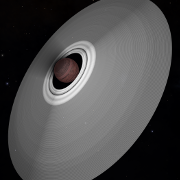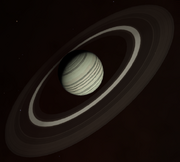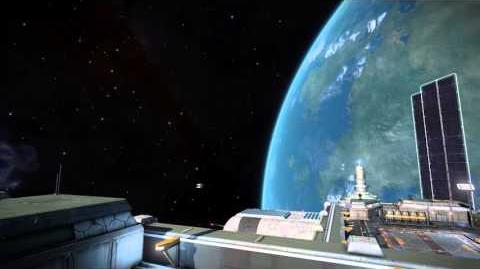m (Link to ED Wiki RU page) |
No edit summary |
||
| (15 intermediate revisions by 6 users not shown) | |||
| Line 1: | Line 1: | ||
| − | There are |
+ | There are two main categories of '''planets''': [[Terrestrial Planet]]s and [[Gas Giant]]s. Some types of Terrestrial Planets support life or meet the conditions necessary for [[terraforming]]. [[Ships]] equipped with a [[Planetary Approach Suite]] may [[Planetary Landings|land on the surface]] of certain Terrestrial Planets. |
The term planet refers to celestial bodies orbiting a [[star]] with a [[gravity]] in a specific range. The gravity of a planet has to be strong enough to hold fluids in a stable state (hydrostatic equilibrium) which prevents them from escaping the planet, and low enough to prevent nuclear processes to start as in stars. |
The term planet refers to celestial bodies orbiting a [[star]] with a [[gravity]] in a specific range. The gravity of a planet has to be strong enough to hold fluids in a stable state (hydrostatic equilibrium) which prevents them from escaping the planet, and low enough to prevent nuclear processes to start as in stars. |
||
| Line 9: | Line 9: | ||
|- |
|- |
||
! scope="col"|Image |
! scope="col"|Image |
||
| − | ! scope="col"| |
+ | ! scope="col"|Type |
| − | ! scope="col" |Colour |
||
! scope="col"|Rarity |
! scope="col"|Rarity |
||
| − | ! scope="col"|In game description |
||
|- |
|- |
||
| + | | rowspan="2"|[[File:Icy-180px.png|thumb]] |
||
| − | |<gallery type="slideshow" position="center" widths="250"> |
||
| − | Icy-180px.png |
||
| − | </gallery> |
||
|Icy Body |
|Icy Body |
||
| + | |Very Common |
||
| − | |Atmospheric: White. |
||
| − | |||
| − | Airless: |
||
| − | |||
| − | Blue, orange, green, yellow, pink (Rare). |
||
| − | |Very Common, especially when orbiting cooler M class stars and brown dwarf stars including classes L, T, and Y. |
||
| − | |Ice world composed mainly of water ice. Worlds like this will not have had much heating in the past, forming in the cooler regions of a star system, and have retained many volatiles as solids within their crust. |
||
|- |
|- |
||
| + | | colspan="2"|''Ice world composed mainly of water ice. Worlds like this will not have had much heating in the past, forming in the cooler regions of a star system and have retained many volatiles as solids in their crust.'' |
||
| − | |<gallery type="slideshow" position="center" widths="250"> |
||
| + | |- |
||
| − | Rocky-Planets-180px.png |
||
| + | | rowspan="2"|[[File:Rocky-Planets-180px.png|thumb]] |
||
| − | </gallery> |
||
|Rocky Body |
|Rocky Body |
||
| + | |Very Common |
||
| − | |Atmospheric: |
||
| − | |||
| − | Yellow, black, brown. |
||
| − | |||
| − | Airless: |
||
| − | |||
| − | Orange, grey, brown, red, green, black. |
||
| − | |Common |
||
| − | |Rocky world with little or no surface metal content. Worlds like this have lost most of their volatiles due to past heating, and any metallic content will form a small central core. |
||
|- |
|- |
||
| + | | colspan="2"|''Rocky world with little or no surface metal content. Worlds like this have lost most of their volatiles due to past heating, and any metallic content will form a small central core.'' |
||
| − | |<gallery type="slideshow" position="center" widths="250"> |
||
| + | |- |
||
| − | Rocky_ice.png |
||
| + | | rowspan="2"|[[File:Rocky ice.png|thumb]] |
||
| − | </gallery> |
||
|[[Rocky Ice World]] |
|[[Rocky Ice World]] |
||
| − | |White - Grey - Light blue - Light brown |
||
|Uncommon |
|Uncommon |
||
| − | |Rocky ice world. Typically formed in the cooler regions of star system these worlds have a small metal core and thick rocky mantle with a crust of very deep ice. Geological activity is common in these worlds because of the large quantities of volatiles in the crust, often creating a thin, sometimes seasonal atmosphere. |
||
|- |
|- |
||
| + | | colspan="2"|''Typically formed in the cooler regions of a star system these worlds have a small metal core and thick rocky mantle with a crust of very deep ice. Geological activity is common in these worlds because of the large quantities of volatiles in the crust, often creating a thin, sometimes seasonal atmosphere.'' |
||
| − | |<gallery type="slideshow" position="center" widths="250"> |
||
| + | |- |
||
| − | High-Metal-Content-Planets-180px.png |
||
| + | | rowspan="2"|[[File:High-Metal-Content-Planets-180px.png|thumb]] |
||
| − | </gallery> |
||
|High-Metal Content World |
|High-Metal Content World |
||
| + | |Common |
||
| − | |Atmospheric: |
||
| − | Yellow, black, brown. |
||
| − | |||
| − | Airless: |
||
| − | |||
| − | Orange, grey, brown, red, green, black. |
||
| − | |Common (Rare if orbiting M, L, T, S class stars) |
||
| − | |High metal content world with a metallic core. Worlds like this can have metallic ores near the surface in places, especially around areas of past volcanism. |
||
|- |
|- |
||
| + | | colspan="2"|''High metal content world with a metallic core. Worlds like this can have metallic ores near the surface in places, especially around areas of past volcanism.'' |
||
| − | |<gallery type="slideshow" position="center" widths="250"> |
||
| + | |- |
||
| − | Metal_rich.png |
||
| + | | rowspan="2"|[[File:Metal rich.png|thumb]] |
||
| − | </gallery> |
||
|[[Metal-Rich Body]] |
|[[Metal-Rich Body]] |
||
| + | |Uncommon |
||
| − | |Atmospheric: Black, brown, visible lava. |
||
| − | |||
| − | Airless: |
||
| − | |||
| − | Typically deep red/orange due to proximity to star. |
||
| − | |Rare, can be found in close orbit around G, F and A class stars. |
||
| − | |Metal-rich worlds like this have a large metallic core, with plentiful metallic ores even at the surface. In places, especially around areas of past or current volcanism or liquid erosion, some higher metals can be found in their elemental form too. Mining is therefore very efficient, so these worlds are highly valued. |
||
| − | |||
| − | This type of planetoid is always within close proximity of a star, often taking the form of a lava-covered planet or a potato planet. |
||
|- |
|- |
||
| + | | colspan="2"|''Metal-rich worlds like this have a large metallic core, with plentiful metallic ores even at the surface. In places, especially around areas of past or current volcanism or liquid erosion, some higher metals can be found in their elemental form too. Mining is therefore very efficient, so these worlds are highly valued.'' |
||
| − | |<gallery type="slideshow" position="center" widths="250"> |
||
| − | Earthlike.png |
||
| − | </gallery> |
||
| − | |Earth-Like World |
||
| − | |Blue with green, brown and white |
||
| − | | |
||
| − | Extremely Rare (Mainly orbit K, G, F class stars) |
||
| − | |||
| − | Said to be less common in the galactic core. |
||
| − | |Outdoor world with a human-breathable atmosphere and indigenous life. The atmosphere is far from chemical equilibrium as a result. |
||
|- |
|- |
||
| + | | rowspan="2"|[[File:Ammonia-World-180px.png|thumb]] |
||
| − | |<gallery type="slideshow" position="center" widths="250"> |
||
| − | Ammonia-World-180px.png |
||
| − | </gallery> |
||
|[[Ammonia World]] |
|[[Ammonia World]] |
||
| − | |Atmospheric: |
||
| − | Light brown, brown, beige. |
||
| − | |||
| − | Airless: |
||
| − | |||
| − | Brown. |
||
|Very Rare |
|Very Rare |
||
| − | |Terrestrial ammonia world with an active ammonia-based chemistry and carbon-ammonia based life. |
||
|- |
|- |
||
| + | | colspan="2"|''Terrestrial ammonia world with an active ammonia-based chemistry and carbon-ammonia based life.'' |
||
| − | |<gallery type="slideshow" position="center" widths="250"> |
||
| − | Nonspherical-Planet.png |
||
| − | Non-Spherical-Planet-2.png |
||
| − | Nonspherical-Moon.png |
||
| − | </gallery> |
||
| − | |Non-spherical Bodies |
||
| − | |Atmospheric: |
||
| − | N/A |
||
| − | |||
| − | Airless: |
||
| − | |||
| − | Grey. |
||
| − | |Rare (Commonly found orbiting M Class stars) |
||
| − | |These are planets or moons with a nonspherical shape, with a radius of less than 1 000 KM. It's elongated and can resemble a potato. Typically do not retain any atmosphere. |
||
| − | |||
| − | Take caution when travelling near nonspherical bodies, as their small size can cause one to believe they are travelling further from the body's orbital cruise zone than they actually are and subsequently colliding at a significant velocity with the celestial body's glide engagement zone, triggering an emergency drop from supercruise and causing starship damage. |
||
|- |
|- |
||
| + | | rowspan="2"|[[File:Water.jpg|thumb]] |
||
| − | |<gallery type="slideshow" position="center" widths="250"> |
||
| + | |[[Water World]] |
||
| − | Emerald-Moon-in-Cemiess.png |
||
| + | |Rare |
||
| − | </gallery> |
||
| − | |Terraformed World |
||
| − | |Blue with green, brown and white |
||
| − | | |
||
| − | Accounts for most Earth-Like Worlds in inhabited areas of space. Cannot be found in deep space |
||
| − | |Outdoor world with a human-breathable atmosphere and indigenous life. The atmosphere is far from chemical equilibrium as a result. |
||
| − | |} |
||
| − | |||
| − | |||
| − | == [[Water World]]s == |
||
| − | {| class="article-table article-table-selected" cellspacing="1" cellpadding="1" border="1" |
||
|- |
|- |
||
| + | | colspan="2"|''Terrestrial water world with an active water-based chemistry and carbon-water-based life.'' |
||
| − | ! scope="col" |Image |
||
| − | ! scope="col" |Class |
||
| − | ! scope="col" |Colour |
||
| − | ! scope="col" |Rarity |
||
| − | ! scope="col" |In game description |
||
|- |
|- |
||
| + | | rowspan="2"|[[File:Earthlike.png|thumb]] |
||
| − | |<gallery type="slideshow" position="center" widths="250"> |
||
| − | + | |Earth-Like World |
|
| + | |Very Rare |
||
| − | THAILOAE EM-M D7-2 A 6.png|THAILOAE EM-M D7-2 A 6 |
||
| + | |- |
||
| − | </gallery> |
||
| + | | colspan="2"|''Outdoor world with a human-breathable atmosphere and indigenous life. The atmosphere is far from chemical equilibrium as a result.'' |
||
| − | |[[Water World]] |
||
| − | |Atmospheric |
||
| − | Blue, often with white (ice). |
||
| − | |||
| − | Airless: |
||
| − | |||
| − | Blue. |
||
| − | |Rare (More common if orbiting K, G, F and A class stars) |
||
| − | |Terrestrial water world with an active water-based chemistry and carbon-water-based life. |
||
| − | |||
| − | Water Worlds may occasionally possess a small cluster of islands. This does not alter its classification, however. |
||
|} |
|} |
||
| Line 156: | Line 64: | ||
{| class="article-table" cellspacing="1" cellpadding="1" border="1" |
{| class="article-table" cellspacing="1" cellpadding="1" border="1" |
||
!Image |
!Image |
||
| + | !Type |
||
| − | !Class |
||
| − | !Rarity |
+ | !Rarity |
| − | !In game description |
||
|- |
|- |
||
| + | | rowspan="2"|[[File:Gas-Giant-Class-I.png|thumb]] |
||
| − | |<gallery type="slideshow" position="center" widths="250"> |
||
| − | + | |Class I |
|
| + | |Common |
||
| − | </gallery> |
||
| − | |I |
||
| − | |Uncommon |
||
| − | |Class I or Jovian gas giants have primarily hydrogen and helium atmospheres. Colouration comes from clouds in the upper atmosphere of ammonia, water vapour, hydrogen sulphide, phosphine and sulphur. The temperature at the top of their upper cloud layers is typically less than 150 K. |
||
|- |
|- |
||
| + | | colspan="2"|''Class I or Jovian gas giants have primarily hydrogen and helium atmospheres. Colouration comes from clouds in the upper atmosphere of ammonia, water vapour, hydrogen sulphide, phosphine and sulphur. The temperature at the top of their upper cloud layers is typically less than 150 K.'' |
||
| − | |<gallery type="slideshow" position="center" widths="250"> |
||
| + | |- |
||
| − | Class_II.png |
||
| + | | rowspan="2"|[[File:Class II.png|thumb]] |
||
| − | </gallery> |
||
| − | |II |
+ | |Class II |
|Rare |
|Rare |
||
| − | |Class II gas giants have primarily hydrogen and helium atmospheres. Water vapour in the upper cloud layers gives them a much higher albedo. Their surface temperature is typically up to or around 250 K. |
||
|- |
|- |
||
| + | | colspan="2"|''Class II gas giants have primarily hydrogen and helium atmospheres. Water vapour in the upper cloud layers gives them a much higher albedo. Their surface temperature is typically up to or around 250 K.'' |
||
| − | |<gallery type="slideshow" position="center" widths="250"> |
||
| + | |- |
||
| − | Gas-Giant-Class-III-180px.png |
||
| + | | rowspan="2"|[[File:Gas-Giant-Class-III-180px.png|thumb]] |
||
| − | 20170221073152_1.jpg |
||
| + | |Class III |
||
| − | Screenshot_20200111-115555.jpg|Type III Green Gas Giant |
||
| + | |Common |
||
| − | </gallery> |
||
| − | | |
+ | |- |
| + | | colspan="2"|''Class III gas giants have primarily hydrogen and helium atmospheres without distinctive cloud layers. Their surface temperature typically ranges between 350 K and 800 K. They are primarily blue in colour because of optical scattering in the atmosphere - with the chance of wispy cloud layers from sulphides and chlorides.'' |
||
| + | |- |
||
| + | | rowspan="2"|[[File:Gas-Giant-Class-IV-180px.png|thumb]] |
||
| + | |Class IV |
||
|Uncommon |
|Uncommon |
||
| − | |Class III gas giants have primarily hydrogen and helium atmospheres without distinctive cloud layers. Their surface temperature typically ranges between 350 K and 800 K. They are primarily blue in colour because of optical scattering in the atmosphere - with the chance of wispy cloud layers from sulphides and chlorides. |
||
|- |
|- |
||
| + | | colspan="2"|''Class IV gas giants have primarily hydrogen and helium atmospheres with carbon monoxide and upper clouds of alkali metals above lower cloud layers of silicates and iron compounds, hence he brighter colours. The temperature of their upper cloud layers is typically above 900 K.'' |
||
| − | |<gallery type="slideshow" position="center" widths="250"> |
||
| − | Gas-Giant-Class-IV-180px.png |
||
| − | </gallery> |
||
| − | |IV |
||
| − | |Very Uncommon |
||
| − | |Class IV gas giants have primarily hydrogen and helium atmospheres with carbon monoxide and upper clouds of alkali metals above lower cloud layers of silicates and iron compounds, hence he brighter colours. The temperature of their upper cloud layers is typically above 900 K. |
||
|- |
|- |
||
| + | | rowspan="2"|[[File:Gas Giant Class V.png|thumb]] |
||
| − | |<gallery type="slideshow" position="center" widths="250"> |
||
| − | + | |Class V |
|
| − | </gallery> |
||
| − | |V |
||
|Very Rare |
|Very Rare |
||
| − | |Class V gas giants have primarily hydrogen and helium atmospheres, with thick clouds of silicates and iron compounds, even metallic iron.They are the hottest type of gas giants with temperatures at their upper cloud decks above 1400 K, and much hotter in the lower layers, often emitting a dull glow from the internal heat within. |
||
|- |
|- |
||
| + | |colspan="2"|''Class V gas giants have primarily hydrogen and helium atmospheres, with thick clouds of silicates and iron compounds, even metallic iron.They are the hottest type of gas giants with temperatures at their upper cloud decks above 1400 K, and much hotter in the lower layers, often emitting a dull glow from the internal heat within.'' |
||
| − | |<gallery type="slideshow" position="center" widths="250"> |
||
| + | |- |
||
| − | Helium-rich_Gas_Giant_2.jpg |
||
| + | | rowspan="2"|[[File:Helium-rich Gas Giant 2.jpg|thumb]] |
||
| − | Helium-rich_Gas_Giant.png |
||
| − | </gallery> |
||
|Helium-rich |
|Helium-rich |
||
|Very Rare |
|Very Rare |
||
| − | |Helium-rich gas giants have a greatly inflated percentage of helium compared to the hydrogen in their atmosphere. Much of their hydrogen has been lost over time because they have insufficient mass to hold on to it. It may also be because temperatures in their past were much higher, driving off the hydrogen at a greater rate. |
||
|- |
|- |
||
| + | | colspan="2"|''Helium-rich gas giants have a greatly inflated percentage of helium compared to the hydrogen in their atmosphere. Much of their hydrogen has been lost over time because they have insufficient mass to hold on to it. It may also be because temperatures in their past were much higher, driving off the hydrogen at a greater rate.'' |
||
| − | |<gallery type="slideshow" position="center" widths="250"> |
||
| − | Gas_giant_with_ammonia_based_life.png |
||
| − | </gallery> |
||
| − | |[[Gas Giant]] with ammonia-based life |
||
| − | |Very Rare |
||
| − | |Gas giant with ammonia-based life. This is primarily a hydrogen and helium-based atmospheric gas giant, but a little below the surface cloud layers,life exists based in the ammonia-cloud layer. The chemistry of this gaseous region is far from equilibrium, with a surprising excess of oxygen and many carbon-based compounds giving it some vivid colours. As with many such gaseous living systems, it is underpinned by vast quantities of free-floating radioplankton - tiny carbon-based algae, each retaining small quantity of liquid ammonia, extracting their energy from the intense radiation flux. |
||
|- |
|- |
||
| + | | rowspan="2"|[[File:Helium-rich Gas Giant.png|thumb]] |
||
| − | |<gallery type="slideshow" position="center" widths="250"> |
||
| + | |Helium Gas Giant |
||
| − | Gas_Giant_Water_Based_Life.png |
||
| − | Water_based_life_gas_giant.png |
||
| − | gas_giant_water_based.jpg|Gas giant, water based |
||
| − | </gallery> |
||
| − | |[[Gas Giant]] with water-based life |
||
|Very Rare |
|Very Rare |
||
| − | |Gas giant with water-based life. This is primarily a hydrogen and helium based atmospheric gas giant, but not far below the surface exists life based in the water-cloud layer just below the atmospheric surface. The chemistry of this gaseous region is far from equilibrium, with a surprising excess of oxygen and many carbon-based compounds giving it some vivid colours. As with many such gaseous living systems, it is underpinned by vast quantities of free-floating radioplankton - tiny carbon-based algae, each retaining small quantity of liquid water, extracting their energy from the intense radiation flux. |
||
|- |
|- |
||
| + | | colspan="2"|''Helium gas giants have primarily a helium atmosphere. They have lost most or all of their hydrogen because they have insufficient mass to hold on to it over time. It may also be because temperatures in their past were much higher, driving off the hydrogen at a greater rate.'' |
||
| − | |<gallery type="slideshow" position="center" widths="277"> |
||
| + | |- |
||
| − | Water_Giant.png |
||
| + | | rowspan="2"|[[File:Gas giant with ammonia based life.png|thumb]] |
||
| − | Water Giant 2.png|Water Giant |
||
| + | |Gas Giant with ammonia-based life |
||
| − | </gallery> |
||
| − | |Water Giant |
||
|Very Rare |
|Very Rare |
||
| − | |Water giant. Worlds like this have a large atmosphere made mainly of water vapour. It most likely formed when a large icy body warmed up enough to evaporate a large amount of its surface ice, this would in turn trigger a runaway greenhouse effect leading to a very thick atmosphere made of the evaporated ices. |
||
| − | |} |
||
| − | |||
| − | == Largest landable planets == |
||
| − | These are the largest known landable planets in the [[galaxy]]. They were all discovered by commanders. Check the [https://forums.frontier.co.uk/threads/really-large-landable-planets-the-list-mk-ii.327917/ forum thread] for the full list.<ref>[https://forums.frontier.co.uk/threads/really-large-landable-planets-the-list-mk-ii.327917/ Really large landable planets: the list. (MK II)] |
||
| − | </ref> |
||
| − | {| class="article-table" |
||
| − | !Rank |
||
| − | !Radius |
||
| − | !System |
||
| − | !Body |
||
| − | !Type |
||
| − | !Reported by |
||
|- |
|- |
||
| + | | colspan="2"|''Gas giant with ammonia-based life. This is primarily a hydrogen and helium-based atmospheric gas giant, but a little below the surface cloud layers,life exists based in the ammonia-cloud layer. The chemistry of this gaseous region is far from equilibrium, with a surprising excess of oxygen and many carbon-based compounds giving it some vivid colours. As with many such gaseous living systems, it is underpinned by vast quantities of free-floating radioplankton - tiny carbon-based algae, each retaining small quantity of liquid ammonia, extracting their energy from the intense radiation flux.'' |
||
| − | |1 |
||
| − | |25,503.96 km |
||
| − | |EOL PROU HR-U D3-2494 |
||
| − | |3 |
||
| − | |Icy body |
||
| − | |''CMDR Ishtar Nixx'' |
||
|- |
|- |
||
| + | | rowspan="2"|[[File:Water based life gas giant.png|thumb]] |
||
| − | |2 |
||
| + | |Gas Giant with water-based life |
||
| − | |25,202.13 km |
||
| + | |Rare |
||
| − | |WEQAEA TN-K D8-53 |
||
| − | |1 |
||
| − | |Icy body |
||
| − | |''duckofdeath'' |
||
|- |
|- |
||
| + | | colspan="2"|''Gas giant with water-based life. This is primarily a hydrogen and helium based atmospheric gas giant, but not far below the surface exists life based in the water-cloud layer just below the atmospheric surface. The chemistry of this gaseous region is far from equilibrium, with a surprising excess of oxygen and many carbon-based compounds giving it some vivid colours. As with many such gaseous living systems, it is underpinned by vast quantities of free-floating radioplankton - tiny carbon-based algae, each retaining small quantity of liquid water, extracting their energy from the intense radiation flux.'' |
||
| − | |3 |
||
| − | |24,403.61 km |
||
| − | |CHROABS TI-S D4-58 |
||
| − | |4 |
||
| − | |Icy body |
||
| − | |''CMDR Raj Matheo'' |
||
|- |
|- |
||
| + | | rowspan="2"|[[File:Water Giant.png|thumb]] |
||
| − | |4 |
||
| + | |Water Giant |
||
| − | |24,353.34 km |
||
| + | |Very Rare |
||
| − | |BLU AESCS LQ-X D1-11 |
||
| − | |2 |
||
| − | |Icy body |
||
| − | |''CMDR King-Crimson'' |
||
| − | |- |
||
| − | |5 |
||
| − | |24,306.84 km |
||
| − | |THUECHO NU-B C15-2 |
||
| − | |2 |
||
| − | |Icy body |
||
| − | |''crnook'' |
||
| − | |- |
||
| − | |6 |
||
| − | |24,276.33 km |
||
| − | |STOCK 1 SECTOR AQ-X D1-22 |
||
| − | |1 |
||
| − | |Icy body |
||
| − | |''Gallus Domesticus'' |
||
| − | |- |
||
| − | |7 |
||
| − | |23,605.51 km |
||
| − | |OEPHAIDST RU-M D8-709 |
||
| − | |2 |
||
| − | |Icy body |
||
| − | |''CMDR Varonica'' |
||
| − | |- |
||
| − | |8 |
||
| − | |23,525.00 km |
||
| − | |GLUDGEIA BD-T C4-5 |
||
| − | |2 |
||
| − | |Icy body |
||
| − | |''CMDR Setterllew'' |
||
| − | |- |
||
| − | |9 |
||
| − | |23,346.00 km |
||
| − | |HYPUAE SCRUA QP-N D7-196 |
||
| − | |3 |
||
| − | |Icy body |
||
| − | |''ick'' |
||
|- |
|- |
||
| + | | colspan="2"|''Water giant. Worlds like this have a large atmosphere made mainly of water vapour. It most likely formed when a large icy body warmed up enough to evaporate a large amount of its surface ice, this would in turn trigger a runaway greenhouse effect leading to a very thick atmosphere made of the evaporated ices.'' |
||
| − | |10 |
||
| − | |23,310.22 km |
||
| − | |FROARSTS CM-M D7-2210 |
||
| − | |2 |
||
| − | |Icy body |
||
| − | |''CMDR chavaplx '' |
||
|} |
|} |
||
| Line 324: | Line 140: | ||
== References == |
== References == |
||
<references /> |
<references /> |
||
| + | |||
[[ru:Планеты]] |
[[ru:Планеты]] |
||
[[Category:Planets]] |
[[Category:Planets]] |
||
Revision as of 01:04, 30 June 2020
There are two main categories of planets: Terrestrial Planets and Gas Giants. Some types of Terrestrial Planets support life or meet the conditions necessary for terraforming. Ships equipped with a Planetary Approach Suite may land on the surface of certain Terrestrial Planets.
The term planet refers to celestial bodies orbiting a star with a gravity in a specific range. The gravity of a planet has to be strong enough to hold fluids in a stable state (hydrostatic equilibrium) which prevents them from escaping the planet, and low enough to prevent nuclear processes to start as in stars.
Some astronomical objects that meet the official criteria for planet status yet also happen to orbit a planet are instead classified as natural satellites or moons. When a moon's orbit expands to the point that the barycentre of the planet-moon system falls outside the center of the planet, then both bodies would be considered planets and part of a double-planet system.[1]
Terrestrial Planets
| Image | Type | Rarity |
|---|---|---|
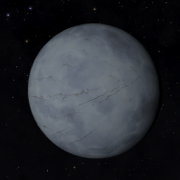 |
Icy Body | Very Common |
| Ice world composed mainly of water ice. Worlds like this will not have had much heating in the past, forming in the cooler regions of a star system and have retained many volatiles as solids in their crust. | ||
 |
Rocky Body | Very Common |
| Rocky world with little or no surface metal content. Worlds like this have lost most of their volatiles due to past heating, and any metallic content will form a small central core. | ||
 |
Rocky Ice World | Uncommon |
| Typically formed in the cooler regions of a star system these worlds have a small metal core and thick rocky mantle with a crust of very deep ice. Geological activity is common in these worlds because of the large quantities of volatiles in the crust, often creating a thin, sometimes seasonal atmosphere. | ||
| High-Metal Content World | Common | |
| High metal content world with a metallic core. Worlds like this can have metallic ores near the surface in places, especially around areas of past volcanism. | ||
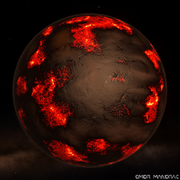 |
Metal-Rich Body | Uncommon |
| Metal-rich worlds like this have a large metallic core, with plentiful metallic ores even at the surface. In places, especially around areas of past or current volcanism or liquid erosion, some higher metals can be found in their elemental form too. Mining is therefore very efficient, so these worlds are highly valued. | ||
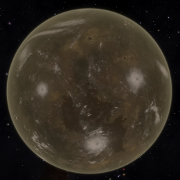 |
Ammonia World | Very Rare |
| Terrestrial ammonia world with an active ammonia-based chemistry and carbon-ammonia based life. | ||
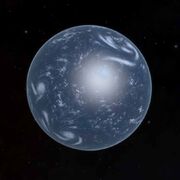 |
Water World | Rare |
| Terrestrial water world with an active water-based chemistry and carbon-water-based life. | ||
 |
Earth-Like World | Very Rare |
| Outdoor world with a human-breathable atmosphere and indigenous life. The atmosphere is far from chemical equilibrium as a result. | ||





